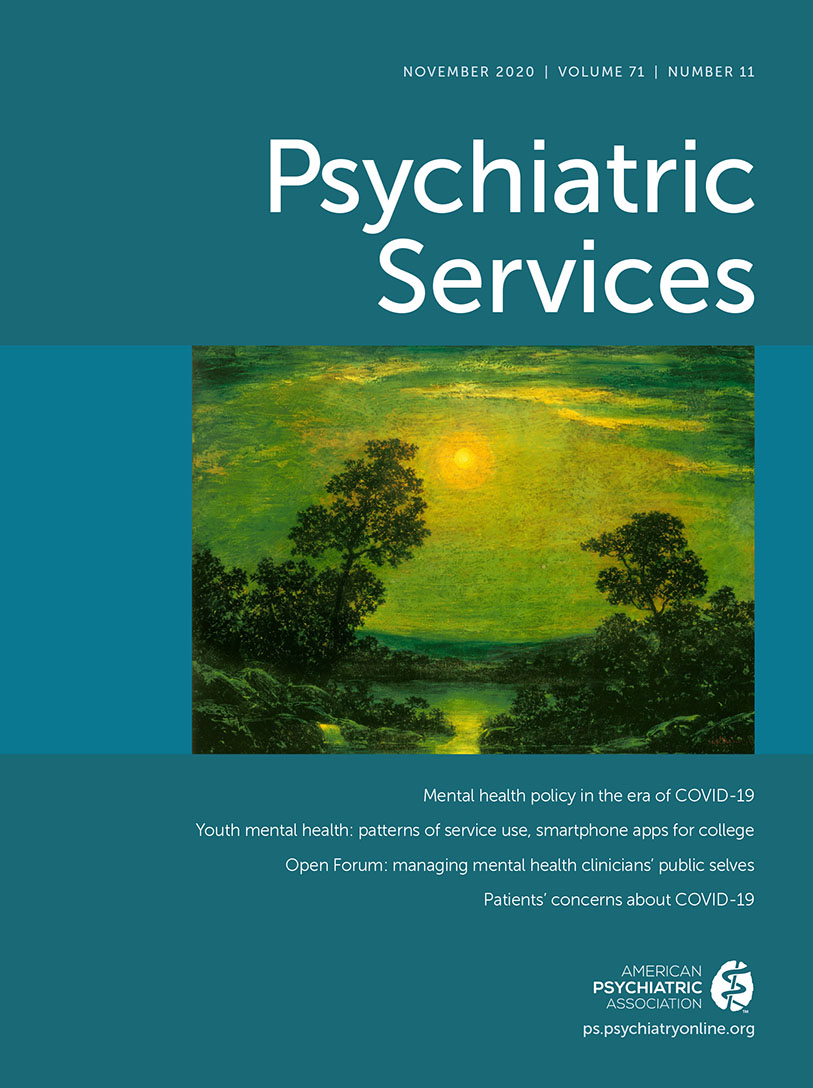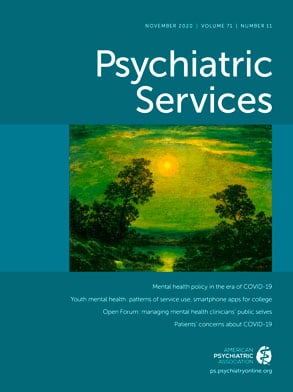The COVID-19 pandemic has been recognized as causing a wide variety of behavioral health problems (
1). On March 17, 2020, a national poll found that 40% of Americans reported life disruption resulting from the COVID-19 pandemic (
2). The impact of quarantine can be long lasting, with substantial psychological impact (
3). Social distancing, disruption of services, and unemployment affect vulnerable populations disproportionately (
4), and people with mental illness are more vulnerable not only to COVID-19 infection but also to its behavioral health consequences. Ultimately, people with mental illnesses will be more affected by social distancing and by disruption of services (
5). Society must mitigate this impact by recognizing that COVID-19 can trigger people’s fears of exacerbating an existing mental illness and by articulating plans that accommodate such people’s needs. Ideally, these plans should receive input from people with mental illness themselves (
4). To this end, an online survey of people with mental illness was conducted about COVID-19 and its impact on their wellness by ForLikeMinds, a website dedicated to promoting mental health recovery and wellness (
6).
ForLikeMinds is an online peer support community dedicated to the recovery and wellness of people living with or supporting someone with mental illness, substance use, or a stressful life event. The website launched in 2018, and its founder is living in recovery from serious mental illness. ForLikeMinds has over 12,000 members in addition to a Facebook community of nearly 18,000 followers (
6). To ask its members and followers about how the COVID-19 pandemic was affecting their lives, ForLikeMinds developed an 11-question survey. Questions asked whether respondents self-identify as having a mental illness and about diagnosis, concerns with the pandemic, coping with the pandemic, and social connectedness and loneliness.
ForLikeMinds leadership contacted the Yale Program for Recovery and Community Health (PRCH) to better understand the results of the COVID-19 survey they had developed and submitted to their participants. We hypothesized that the results from the survey developed and conducted by ForLikeMinds could help advance understanding of the impact of the COVID-19 pandemic among people with mental illness. This could help shape interventions specifically designed to minimize the impact of the COVID-19 pandemic on this population.
Methods
A survey about COVID-19 for people with mental illness was developed by ForLikeMinds and distributed online to its members (N=12,000) and Facebook community. The SurveyMonkey platform was used to distribute the survey during the last week of March 2020. Responses were voluntary and anonymous. PRCH was contacted to help interpret the results. An Excel spreadsheet with the deidentified data was sent for analysis. SPSS was used to determine frequencies of responses. Cross-tabulation was used to establish correlation between nominal variables (such as diagnosis and feeling lonely because of the pandemic). Fisher’s exact test was used to determine which correlations were statistically significant. Analysis of variance was used to establish association between nominal variables (e.g., diagnosis) and the absolute number of concerns participants had about the pandemic. For all correlations, significance was determined at the level of p<0.05.
Results
A total of 214 people responded to the survey, of whom 193 (90%) self-identified as living with a mental illness. Nineteen percent (N=41) of all participants and 10% (N=19) of those living with a mental illness said they supported someone living with a mental illness. Of those living with a mental illness, 84% (N=162) reported having an anxiety disorder, 53% (N=103) as having major depression, 40% (N=78) as having bipolar disorder, 40% (N=77) as having posttraumatic stress disorder, 13% (N=25) as having obsessive-compulsive disorder, 12% (N=24) as having borderline personality disorder, 2% (N=3) as having schizophrenia, and 15% (N=29) as having other disorders. Almost all participants living with a mental illness (98%, N=188) said they had at least one major concern regarding the COVID-19 pandemic, and 62% (N=119) said they had at least three major concerns. Eighty-nine percent (N=172) of participants living with a mental illness had at least one major concern related to their mental illness, and 92% (N=178) of participants had at least one other major concern not directly related to their mental health care.
Sixty-four percent (N=123) of respondents living with a mental illness were concerned that their mental illness would worsen because of the COVID-19 pandemic. Thirty-nine percent (N=76) were concerned that they would not be able to receive mental health care, and 38% (N=74) were concerned that they would run out of medication. In regard to other concerns not directly related to mental health care, 74% (N=143) of participants living with a mental illness were afraid that someone in their family or they themselves were going to get sick with COVID-19, 30% (N=58) were afraid of losing income, 23% (N=44) were afraid of not being able to afford testing and/or treatment for COVID-19, and 18% (N=34) said they could not afford to shelter in place and miss work. Only 12% (N=23) of participants thought they were coping well with the pandemic, whereas 23% (N=44) said they were coping poorly; 68% (N=132) felt they were more isolated, and 57% (N=110) felt they were less socially connected. When people living with a mental illness were asked about who they were connecting with, 72% (N=138) said they were connecting with family, 57% (N=109) with friends, 16% (N=30) with coworkers, and 14% (N=27) with peers. The preferred form of communication was text messages (86%, N=166), followed by phone (73%, N=141) and social media (66%, N=127). Altogether, 97% (N=187) of participants who self-identified as having a mental illness used one of these three forms to communicate.
Respondents’ concern that their mental illness would worsen was associated with the diagnosis of anxiety (p=0.001), fear of not getting treatment (p=0.045), fear that someone in their family or they themselves would get sick (p=0.045), and coping poorly with the pandemic (p=0.001). Fear of running out of medication was associated with diagnosis of major depression (p=0.026), diagnosis of borderline personality disorder (p=0.031), fear of getting worse (p=0.005), concern with not being able to afford treatment (p=0.001), and concern with not being able to afford staying home from work (p=0.02). Responses from people who self-identified as having anxiety were associated with concern that caregivers would be unable to provide support (p=0.045), concern about not getting treatment (p=0.037), concern about getting sick (p=0.026), and coping poorly (p=0.017). Responses from people who self-identified as having major depression were associated with the diagnosis of bipolar disorder (p<0.001), fear of running out of medication (p=0.026), and fear of getting sick (p=0.011). These respondents were also less connected to family (p=0.014). Responses from people who self-identified as having borderline personality disorder were associated with concern about not being able to stay home and miss work (p=0.006), concern about not being able to receive mental health treatment (p=0.003), concern with running out of medication (p=0.031), and concern about not being able to care for loved ones living with mental illness (p=0.038). Responses from people who said they were coping poorly with the COVID-19 pandemic were associated with the self-diagnosis of anxiety (p=0.017), concerns of getting worse (p=0.001), concern of developing a new mental illness (p=0.039), concern of not getting access to treatment (p=0.041), concerns that caregivers would not be able to provide support (p=0.022), feeling isolated (p=0.033), less connectivity to friends (p=0.019), and less connectivity to family (p=0.001). There was also a negative association between coping poorly with the COVID-19 pandemic and using the phone as a form of staying in touch with people (p<0.001). Interestingly, no significant associations were found between coping poorly with COVID-19 and using text messages or social media as a form of staying in touch with people.
The analysis of variance demonstrated a significant correlation between having an anxiety disorder and number of concerns (p<0.001).
Discussion and Conclusions
The survey was conducted during the third week of shelter-in-place recommendations on the East Coast of the United States. It was not surprising to learn that practically all survey participants living with a mental illness expressed significant concerns with the COVID-19 pandemic and with how it would affect their mental health. People living with a mental illness have to deal not only with all the uncertainty related to the pandemic but also with the possibility of disruption of the strategies each one has built to support his or her ongoing recovery. Adding to the fear of disruption is the fact that not everyone has a family member or a friend he or she can count on if needed. Feeling more isolated during the pandemic was very prevalent. More concerning was the fact that almost 60% of participants felt less socially connected when compared with the period before the COVID-19 pandemic. Those who felt less connected were significantly more concerned about the worsening of their condition and running out of medication. Concerns with the need to work, fear of not being able to afford costs of treatment, and fear of not being able to provide and care for loved ones with a mental illness were also present.
Self-identified diagnosis was correlated with several variables. A predictable yet noteworthy finding was that people who self-identified as having anxiety reported the most concerns. They were the group, together with the posttraumatic stress disorder group, that seemed to be most affected by COVID-19. We also found a significant correlation between anxiety disorder and coping poorly with COVID-19. Coping poorly with COVID-19 was of major concern for this population. They felt more isolated and were less connected to family and friends. They were concerned with their treatment, with access to medication, with getting worse, and with developing a new mental illness. Specific measures or strategies could be developed to target this population and minimize the impact of the consequences of the COVID-19 pandemic.
Encouraging information from this survey is that nearly all respondents said that they were accessible through phones, text messaging, and social media. In fact, they were already using these means to minimize social isolation and to remain informed. It is important to notice that people who said they were coping poorly with the consequences of the pandemic were not using their phone as much to communicate and stay in touch with people. In reaching out to this population, providers should consider using text messaging and social media as preferred methods. Virtual platforms can also be an effective way of involving people living with mental illness in building new strategies and solutions to minimize disruption of care.

